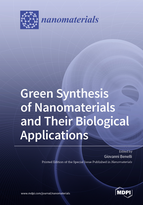Green Synthesis of Nanomaterials and Their Biological Applications
A special issue of Nanomaterials (ISSN 2079-4991). This special issue belongs to the section "Biology and Medicines".
Deadline for manuscript submissions: closed (30 June 2021) | Viewed by 29388
Special Issue Editor
Interests: insect behaviour; biological control; chemical ecology; mating disruption; ecotoxicology; integrate pest and vector management; One Health
Special Issues, Collections and Topics in MDPI journals
Special Issue Information
Dear Colleagues,
Nanomaterials possess highly interesting physical and chemical properties. They have a key role in the development of novel and effective insecticides, acaricides, fungicides, drugs, catalysts and sensors, to cite just some key categories. The synthesis of nanomaterials is often achieved with chemical and physical methods needing the use of extremely toxic chemicals or high-energy inputs. To reduce the environmental impact of these synthetic routes, researchers have recently shifted on the “green synthesis”, where microbial, animal-, and plant-borne compounds can be used as cheap reducing and stabilising agents to fabricate nanomaterials. Green synthesis routes are cheap, eco-friendly, allowing the fabrication of nanomaterials with controlled size and shape—two key features determining their bioactivity. However, real-world applications of green-fabricated nanomaterials are largely unexplored. In this framework, our journal Nanomaterials already dedicated a successful Special Issue on the topic ("Green synthesis of nanomaterials" in 2018-2019).
The present Special Issue represents the continuation of the former one, with a collection of top-quality articles in this research area. Particular attention is devoted to entomological research, since the widespread overuse of synthetic insecticides leads to quick development of resistance in target species as well as to serious non-target effects on human health and environment. A comparable scenario is well recognised in parasitology about the employ of drugs to manage protozoan parasites and helminths, with extremely risky consequences for public health. Therefore, developing new and effective products to fight pests and parasites is a major challenge for modern entomology and parasitology. Despite the huge amount of research on the so-called “green” insecticides and antiparasitics, mainly covering products of microbial and botanical origin, their practical use in real-world conditions remains limited. This is often due to lack of prolonged efficacy and challenging regulations. Thus, nanotechnologies are currently considered a major option to improve the efficacy and stability of both classic and green insecticides, repellents and antiparasitic drugs, relying to various nanocarriers, including nanoencapsulation and nanoemulsions.
Overall, the present Special Issue is open to submissions about green synthesis of nanomaterials as well as on the possible biological applications, including studies dealing with entomology, parasitology, biomedicine, and environmental research. Both Original researches and Reviews will be considered for publication.
Dr. Giovanni BenelliGuest Editor
Manuscript Submission Information
Manuscripts should be submitted online at www.mdpi.com by registering and logging in to this website. Once you are registered, click here to go to the submission form. Manuscripts can be submitted until the deadline. All submissions that pass pre-check are peer-reviewed. Accepted papers will be published continuously in the journal (as soon as accepted) and will be listed together on the special issue website. Research articles, review articles as well as short communications are invited. For planned papers, a title and short abstract (about 100 words) can be sent to the Editorial Office for announcement on this website.
Submitted manuscripts should not have been published previously, nor be under consideration for publication elsewhere (except conference proceedings papers). All manuscripts are thoroughly refereed through a single-blind peer-review process. A guide for authors and other relevant information for submission of manuscripts is available on the Instructions for Authors page. Nanomaterials is an international peer-reviewed open access semimonthly journal published by MDPI.
Please visit the Instructions for Authors page before submitting a manuscript. The Article Processing Charge (APC) for publication in this open access journal is 2900 CHF (Swiss Francs). Submitted papers should be well formatted and use good English. Authors may use MDPI's English editing service prior to publication or during author revisions.
Keywords
- biotechnology
- eco-friendly nanomaterials
- entomology
- green nanosynthesis
- nanoencapsulation
- nanoemulsion
- nanoparticles
- nanopesticides
- parasitology
- nanobiomedicine







